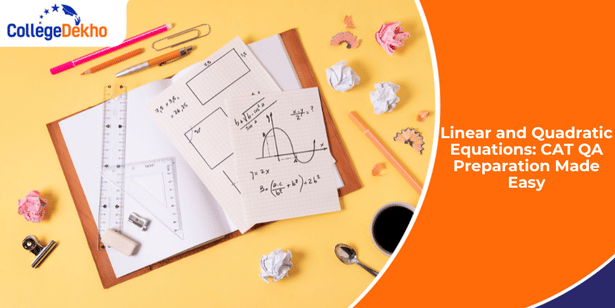
You need to have a thorough knowledge of Linear and Quadratic equations if you are going to score marks in the Quantitative Aptitude section of the CAT 2025 exam. They are easy algebra concepts, but they greatly influence how quickly you will be able to answer difficult questions. In the previous CAT exams, the candidates typically got around 1 to 2 questions from these subjects, and these are primarily scoring subjects if you practice them regularly. Because QA has too much weightage and is also time-bound, accuracy in such equation-type questions in such core subjects could improve your overall percentile. Compared to lengthy arithmetic or geometry problems, these questions based on equations are time-saving, which actually works in your favour during the exam.
Also Read: Topics You Should Not Skip in CAT Quant 2025
What are Linear and Quadratic Equations?
As you start learning algebra, two of the most important topics you will come across are Linear and Quadratic equations in the CAT QA section. These concepts serve as lead-ins to more complex math and have numerous practical applications, ranging from business profit to forecasting outcomes.
Linear Equations
-
A linear equation is an algebraic expression in which the variable contains the highest power of 1. It takes the form ax + b = c, where
- a, b, and c are constants, and x represents the variable.
- Its graph, if plotted, always yields a straight line as output.
- Equation value refers to the position at which the line touches the x-axis.
-
For two variables, i.e., in cases such as in equations, a1x + b1y = c1 and a2x + b2y = c2.
- In this instance, there will be a single common solution.
- If lines are parallel, there is no solution.
- If they overlap entirely, there are an infinite number of solutions.
Quadratic Equations
A quadratic equation takes the form ax² + bx + c = 0, in which a ≠ 0. The highest exponent of x in this one happens to be 2, and this produces, on the graph, a U-shaped curve known as a parabola. That kind of solution depends on the discriminant value D = b2 − 4ac:
- If D>0, two distinct real roots exist.
- If D=0, one real root (repeated) exists.
- If D<0, the roots are imaginary.
Key Concepts and Formulas for Linear and Quadratic Equations for CAT
Refer to the table given below to learn and get familiar with the key concepts and formulas related to Linear and Quadratic Equations for the CAT 2025 QA section:

Preparation Tips to Solve Linear and Quadratic Equations in CAT QA
If you are preparing for the CAT QA section, understanding Linear and Quadratic Equations can significantly help you achieve a high score. These topics frequently appear in questions and also serve as the basis for more advanced problems in Algebra and Arithmetic. Recently, about 12 to 15% of QA questions in CAT exams related to Algebra have been directly on these topics, so it is essential to practise them.
Importance of Linear and Quadratic Equation Topics
- Linear and Quadratic equations topics keep appearing in CAT and other MBA entrance exams like XAT and SNAP in their straightforward forms or in the form of camouflaged word problems.
- Having a good grasp of them enhances your speed while performing tougher topics like inequalities, functions, or logarithms.
How to Prepare
- Reinforce foundations: Be comfortable with simultaneous equations, factorising, using the quadratic formula, and examining the nature of roots using the help of the discriminant.
- Practice mixed questions: Work on modulus equations, absolute value equations, and word problems that involve constructing equations from everyday life.
-
Quick tips:
- Use factorising if possible.
- Use the quadratic formula if the roots are not factorable.
- Split terms carefully for rational roots.
- Split modulus questions into tractable cases.
Practical Tips
- Begin with linear equations to get a feel and idea, and then shift to quadratic equation topics and questions.
- Practice substituting options while solving MCQs under time limits. This is a good practice in the CAT's time-strapped scenario.
- Regular CAT mock tests and sectional tests should be attempted. It can be ensured that you eliminate careless mistakes and achieve accuracy at the right time by solving 20 to 25 algebra questions per week.
By focusing on key strategies, you can ace Linear and Quadratic equations in the CAT 2025 Quant section. Begin with easy and medium questions, taking care to maintain precision and pace. Apply shortcuts like substitution and option elimination to quickly solve questions. Practice frequent question types like word problems, ratios, and time-work. Avoid calculation mistakes and practice answers to gain confidence and overall CAT Quant scores. With 22 questions in 40 minutes, time management is very important; calm down and leave difficult questions for later to reach the highest marks.
Related Reads:
Are you feeling lost and unsure about what career path to take after completing 12th standard?
Say goodbye to confusion and hello to a bright future!

FAQs
The main difference between linear and quadratic equations is that a linear equation forms a straight line and has variables with the highest power of 1 (like y = mx + c). A quadratic equation forms a curve called a parabola and has a variable raised to the power of 2 (like y = ax² + bx + c). Linear means a constant rate of change, and quadratic means a changing rate of change.
For solving linear equations with two variables in the CAT exam, focus mainly on three methods:
- Substitution Method: Solve one equation for one variable, then substitute it in the other to find both variables.
- Elimination Method: Multiply equations to align coefficients and then add or subtract to eliminate one variable.
- Cross-Multiplication: Use determinants for quick solutions when coefficients are clean.
To solve absolute value equations with quadratic or linear terms in the CAT exam, first isolate the absolute value expression. Then split the problem into two cases: one where the inside equals the positive value and one where it equals the negative. Solve each resulting equation separately and check for valid solutions.
Yes, linear and quadratic equations can definitely appear as word problems in the CAT Quantitative Aptitude section. These problems often involve real-life scenarios such as ages, work-time, speed-distance, and mixtures. You may need to form and solve equations from the problem statement using methods like substitution or factorisation.
To practice linear and quadratic equations effectively for CAT, start by mastering basic formulas and concepts. Solve past CAT questions and daily practice sets regularly. Break problems into smaller parts and learn to spot patterns. Time yourself to improve speed and accuracy. Focus on both factorisation and formula methods. Skip tough questions first, then return for sure attempts.
Was this article helpful?




















Similar Articles
List of CAT 2025 RC Top Recommended Books
SNAP 2025 High-Scoring Data Interpretation Topics
MAH MBA/ MMS CET 2026 Domicile Rules - Check Rules for State Candidature & All India Candidature
Skills You Gain from an Executive MBA Program
How to Stay Calm and Focused to Ace CAT 2025 DILR
Maximize CAT 2025 DILR Score: Proven Sectional Test Strategies That Work